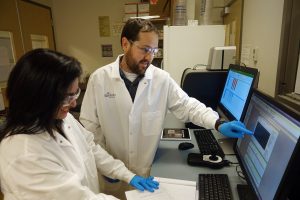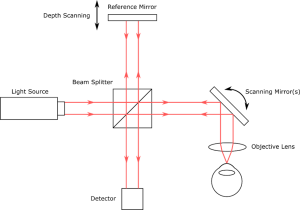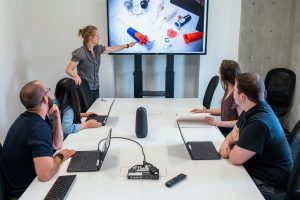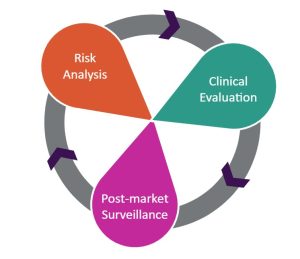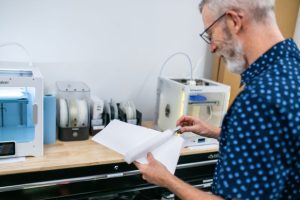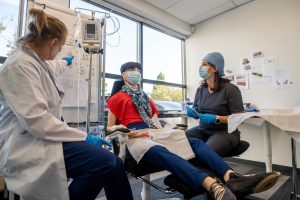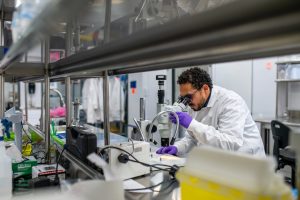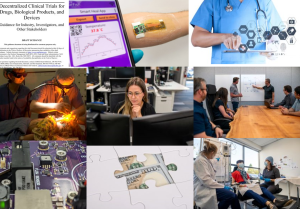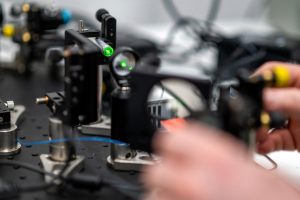 Commercializing a medical device with optical components brings a unique set of challenges. We asked our multi-disciplinary team of engineers, regulatory, manufacturing and optics experts to share their experiences and lessons learned for commercializing medical devices with optics components and interacting with optics engineers.
Commercializing a medical device with optical components brings a unique set of challenges. We asked our multi-disciplinary team of engineers, regulatory, manufacturing and optics experts to share their experiences and lessons learned for commercializing medical devices with optics components and interacting with optics engineers.
Learn what they pay attention to and how they change behavior from commercializing medical devices without optical components.
Tolerancing
Tolerances are always the first thing that Mechanical Engineers (MEs) ask about when working on a device with optics. The usual optical engineer answer is “make it as good as possible”. The optical tolerance will usually be tight, at least initially. This often leads to early designs that incorporate a high degree of adjustability to precisely dial-in the positions/orientations of the optical components. In such cases, adjustments are made to bring the system into proper alignment optically, as opposed to dimensionally.
In more mature designs, the number of adjustable components should be limited as much as possible to increase the device’s stability and reduce the time and training needed for manufacture. In such designs, the tolerances are controlled through detailed optomechanical design, though some adjustable components may nonetheless be necessary.
TIP: Ideally the number of adjustable parts should be limited as much as possible while otherwise meeting requirements (a lot of adjustability reduces stability and can increase manufacturing time).
Cleanliness
Cleanliness is paramount when handling optical components for prototypes. As development progresses, cleanliness includes carefully handling incoming parts and sealing enclosures to prevent dust and ingress of materials or even humidity. The specific optical cleanliness requirements will depend on the application: A device that steers a high-powered laser beam may require a high level of protection from dust; An optics system strapped to an airplane may require protection from water condensation caused by changes in atmospheric pressure.
Specific cleanliness requirements can also depend on the stage of the project: What environment will the optics be in for development and what does the team need to learn at this point in time? Does it matter if the environment is not perfectly clean in the short term or is extra cleaning work required for testing purposes? Are the requirements the same when the device is out in a dusty real-world environment? A dusty real-world environment typically requires a higher level of ingress protection than is needed for testing.
TIP: Consider cleanliness requirements when developing an optical system. The requirements will come from a combination of the environment in which the device will be situated, the stage of device development, and the specific application carried out by the device. At the same time, to avoid unnecessary overhead during development, bear in mind that the cleanliness requirements for initial implementations may be looser than those required by the final product.
Light Sources
Not all light is created equal. There are a lot of variables in light sources, typically wavelength and wavelength spread (bandwidth or “coherence’), power, the number of sources, their type (lens, direct illumination, or diffuse) and shape. All these variables have implications for the function of the light source and the safety of the device. Finding a balance amongst all the relevant variables can be a challenge.
Light Interaction with Human Body
With an ophthalmic instrument that incorporates optics, the last part of the optical system is almost always the person’s eye, which has a lot of physiological variation and will affect the properties of light incident on it. Additionally, the eye is always moving and is very difficult to track.
Oftentimes, physiological interaction with the eye is more complex than cutting into flesh or heating something up or cooling it down, where the interaction is somewhat more predictable and consistent. This leads generally to a lot of complexity ensuring that the requirements for a safe and effective device are met. Furthermore, the requisite safety calculations depend on many properties of the light and must consider how the light interacts with various tissues of the eye, as well as how the eye affects the propagation of the light as it approaches the fundus.
Measuring Short Laser Pulses
Photodetectors used to convert energy from short duration laser pulses (nanoseconds or less) into digital signals often require high speed, low noise amplifiers. Various aspects of such designs can be challenging. Properly suppressing parasitic signals or finding components that meet the device requirements often requires some iteration with the optics team and supplier on an ideal specification. Measuring slower pulses typically does not require the same level of consideration.
Build and Test or Analyze?
One way to tackle a problem is to analyze. Another is to build and test. Optics engineers rarely skip the analysis step. There are often too many variables to skip it with any chance of success. Whether it is first principles, optical design software, or some combination of the two, analysis is necessary to optimize the probability of building a successful device. Domains like mechanical, human factors, etc., can sometimes use a level of intuition and then build, test and iterate. However, optical devices could dramatically miss the mark if any number of variables are wrong.
TIP: Intuition is often insufficient when it comes to optics. Analysis by first principles or optical design software is often necessary to understand the relevant variables and to optimize the chances of success.
In-House or Outsource?
Optics doesn’t stand alone as a discipline within development. At any point, it’s going to be tightly coupled to one, if not many other disciplines. For example: electrical or mechanical considerations must be considered, images that are created must interface tightly with software development, and the interaction of patients with the device must be considered. An optics problem is a systems problem, not just an individual domain problem. EEs often interact in an interdisciplinary manner with mechanical engineers and software. Optics tends to glue the three disciplines together in some way or another when exploring design tradeoffs.
Oftentimes when the solution is decomposed into subsystems there can be a drive to outsource each subsystem to a different specialty contractor. Having all the disciplines under one roof (including optics, QA/RA and manufacturing) facilitates seamless collaboration as the team invents novel solutions to novel challenges.
When an element of optical design is outsourced, the optical designer will deliver exactly what was requested. But, in the early stages of product development, developers don’t always know what to ask for, or they ask for the wrong thing. Having fluid, unfiltered conversations is key. Otherwise, the process can become a long and fruitless Iterative loop.
Optical designers speak a different language using terms like scratch, dig and wavefront error instead of more common general roughness, surface quality or surface finish metrics. Translating between the two languages can be difficult. Being part of a single development team can help.
TIP: Having expertise in the required disciplines in-house (or at a single outsourcing partner) makes the design effort more efficient and more effective.
EE Challenge – Pushing the Edge
More often than other applications, optical applications require real design compromises and awareness of all the edge cases in electrical engineering. Optical applications can require Electrical Engineers (EEs) to deal with a wide range of signal qualities, both in bandwidth (number of frequencies to process) and in terms of strength.
Some devices generate a fair amount of light and a comfortable signal-to-noise ratio. Others push the boundary edge where EEs need to meet a very tight compromise. Usually, one of these edges has flexibility. But when a device pushes both boundaries of bandwidth and low light, EEs must consider part selection, understand the conversion of current to sensed volage (transimpedance amplifiers), the impact of different electrical signal-conditioning architectures, and then consider how to compromise between different parameters like bandwidth, stability, and sensitivity.
Managing The Big Picture
Systems engineering takes a big problem and breaks it down into smaller pieces. System Engineers figure out what the system needs to do, and then make sure everybody is talking to each other. When Optical Engineers must dive into nitty gritty technical details like wavefront error, coherence, photon shot noise, etc. to develop an optical solution, Systems Engineers keep their eye on that and make sure the whole team is headed in the right direction.
We hope the lessons learned and tips in this blog have helped you better understand the unique challenges of commercializing a medical device with optics. We would love to hear tips and lessons from readers. Contact us if you are developing a device with optics and would like to discuss your project.
Astero StarFish is the attributed author of StarFish Medical team blogs. We value teamwork and collaborate on all of our medical device development projects.
- SEO Powered Content & PR Distribution. Get Amplified Today.
- PlatoData.Network Vertical Generative Ai. Empower Yourself. Access Here.
- PlatoAiStream. Web3 Intelligence. Knowledge Amplified. Access Here.
- PlatoESG. Carbon, CleanTech, Energy, Environment, Solar, Waste Management. Access Here.
- PlatoHealth. Biotech and Clinical Trials Intelligence. Access Here.
- Source: https://starfishmedical.com/blog/commercializing-medical-devices-with-optics/
- :has
- :is
- :not
- :where
- $UP
- 200
- 300
- 5
- 8
- a
- About
- Additionally
- adjustable
- adjustments
- affect
- affects
- Airplane
- alignment
- All
- almost
- alone
- also
- always
- amongst
- amount
- an
- analysis
- analyze
- and
- Another
- answer
- any
- Application
- applications
- approaches
- architectures
- ARE
- AS
- ask
- asked
- aspects
- At
- atmospheric
- attention
- author
- avoid
- awareness
- Balance
- Bandwidth
- BE
- Beam
- Bear
- become
- behavior
- being
- Better
- between
- Big
- Blog
- blogs
- both
- boundaries
- breaks
- bring
- Brings
- build
- Building
- but
- by
- calculations
- CAN
- carefully
- carried
- cases
- caused
- challenge
- challenges
- challenging
- Chance
- chances
- change
- Changes
- clean
- Cleaning
- collaborate
- collaboration
- COM
- combination
- come
- comes
- comfortable
- Common
- complex
- complexity
- components
- compromise
- Consider
- consideration
- considerations
- considered
- consistent
- Contractor
- controlled
- conversations
- Conversion
- convert
- could
- coupled
- created
- Current
- cutting
- deal
- Degree
- deliver
- depend
- Design
- Designer
- designers
- designs
- detailed
- details
- develop
- developers
- developing
- Development
- development team
- device
- Devices
- different
- difficult
- DIG
- digital
- direct
- direction
- discipline
- disciplines
- discuss
- Display
- dive
- do
- does
- Doesn’t
- domain
- domains
- Dont
- down
- dramatically
- drive
- duration
- during
- Dust
- each
- Early
- Edge
- edges
- Effective
- efficient
- effort
- electrical engineering
- element
- energy
- engineer
- Engineering
- Engineers
- ensuring
- Environment
- equal
- error
- etc
- Ether (ETH)
- Even
- everybody
- exactly
- example
- Experiences
- expertise
- experts
- Exploring
- extra
- eye
- facilitates
- factors
- fair
- Figure
- final
- finding
- finish
- First
- Flexibility
- fluid
- For
- from
- function
- Furthermore
- General
- generally
- generate
- going
- good
- Handling
- Have
- having
- headed
- hear
- help
- helped
- Hidden
- High
- higher
- hope
- How
- How To
- However
- HTTPS
- human
- human factors
- ideal
- ideally
- if
- images
- Impact
- implementations
- implications
- in
- incident
- includes
- Including
- Incoming
- incorporate
- incorporates
- Increase
- individual
- initial
- initially
- instead
- instrument
- insufficient
- interact
- interacting
- interaction
- interacts
- Interface
- into
- intuition
- invents
- IT
- iteration
- jpeg
- just
- Keep
- Key
- Know
- language
- Languages
- laser
- Last
- Leads
- LEARN
- learned
- least
- Lens
- less
- Lessons
- Lessons Learned
- Level
- light
- like
- Limited
- Long
- Lot
- love
- Low
- made
- make
- MAKES
- manner
- manufacturing
- many
- mark
- materials
- Matter
- mature
- max-width
- May..
- measuring
- mechanical
- medical
- medical device
- medical devices
- Meet
- meeting
- met
- Metrics
- mind
- miss
- more
- more efficient
- moving
- much
- multi-disciplinary
- must
- necessary
- Need
- needed
- needs
- Noise
- nonetheless
- novel
- number
- of
- often
- on
- ONE
- opposed
- optical
- Optical components
- optics
- Optimize
- or
- Other
- Others
- otherwise
- our
- out
- outsource
- Outsourcing
- overhead
- parameters
- Paramount
- part
- partner
- parts
- patients
- Pay
- perfectly
- pieces
- plato
- Plato Data Intelligence
- PlatoData
- player
- Point
- possible
- power
- precisely
- Predictable
- pressure
- prevent
- principles
- probability
- Problem
- process
- Product
- product development
- progresses
- project
- propagation
- proper
- properly
- properties
- protection
- prototypes
- purposes
- Push
- pushes
- Pushing
- qualities
- quality
- range
- rarely
- ratio
- readers
- real
- real world
- reduce
- reduces
- regulatory
- relevant
- requested
- require
- required
- Requirements
- requires
- requisite
- right
- roof
- safe
- Safety
- same
- scratch
- seamless
- selection
- Sensitivity
- set
- Shape
- Share
- Short
- shot
- should
- Signal
- signals
- Simple
- single
- situated
- slower
- smaller
- Software
- software development
- solution
- Solutions
- some
- something
- sometimes
- somewhat
- Source
- Sources
- speak
- Specialty
- specific
- specification
- speed
- spread
- Stability
- Stage
- stages
- stand
- Starfish
- Step
- strength
- success
- successful
- such
- supplier
- suppressing
- sure
- Surface
- system
- Systems
- tackle
- takes
- talking
- team
- Technical
- tends
- term
- terms
- test
- Testing
- than
- that
- The
- their
- then
- There.
- These
- they
- thing
- this
- those
- though?
- three
- Through
- tightly
- time
- tips
- tissues
- to
- together
- tolerance
- tolerances
- too
- track
- tradeoffs
- Training
- two
- type
- typically
- under
- understand
- unique
- unnecessary
- use
- used
- using
- usual
- usually
- value
- variables
- various
- very
- Video
- was
- Water
- Way..
- we
- WELL
- What
- when
- whether
- which
- while
- whole
- wide
- Wide range
- will
- with
- within
- without
- Work
- working
- would
- Wrong
- you
- Your
- youtube
- zephyrnet

